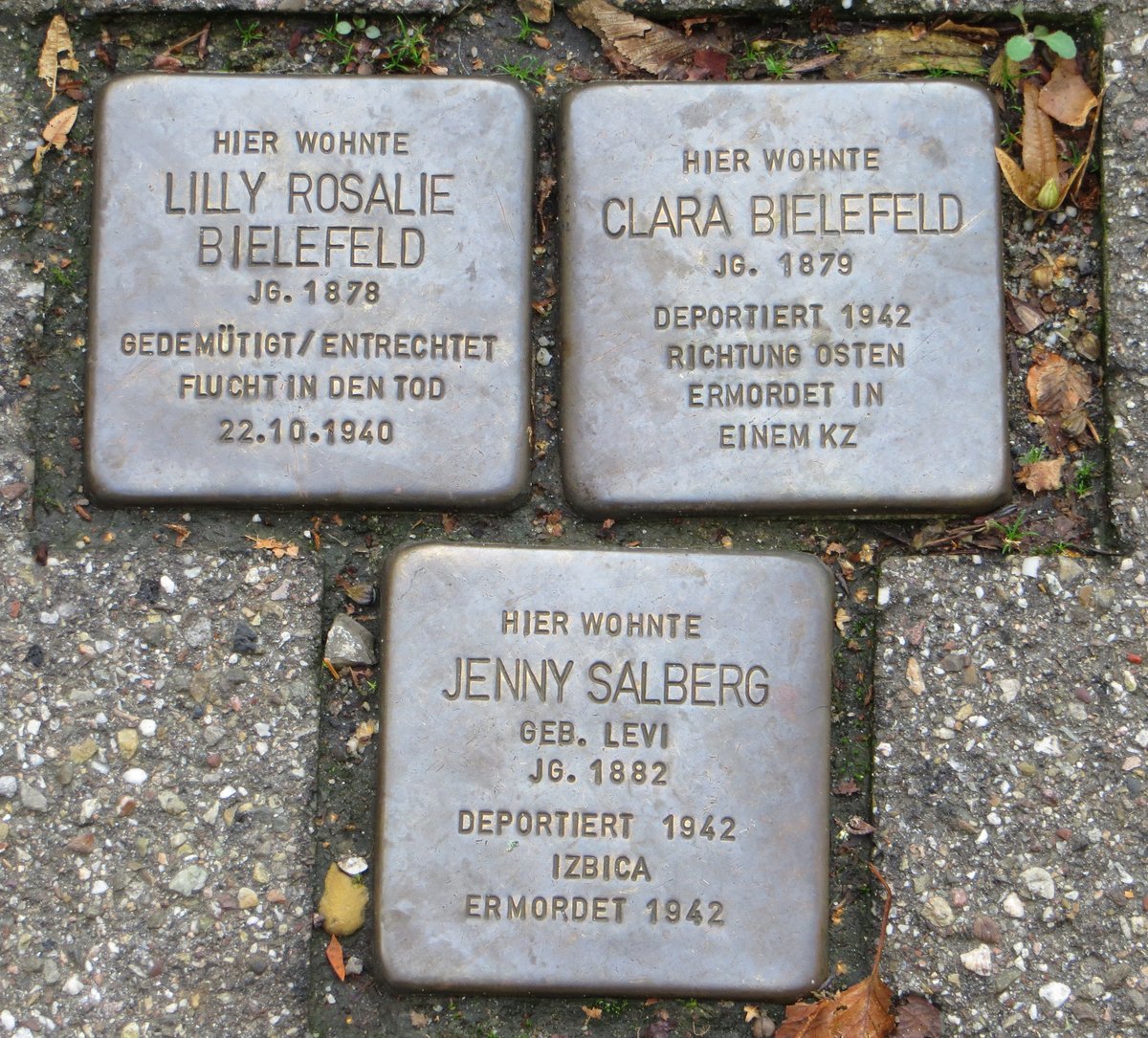
Stolperstein Jenny Salberg Baden-Baden: Visiting Hours, Tickets, and Historical Significance
Date: 14/06/2025
Introduction
Visiting the Stolperstein dedicated to Jenny Salberg in Baden-Baden offers a deeply personal encounter with the memory of those persecuted during the Holocaust. The Stolpersteine project transforms ordinary city streets into living memorials, ensuring that the stories of victims like Jenny Salberg are not forgotten. This comprehensive guide provides historical context, practical visitor information—including location, accessibility, and etiquette—and suggestions for further exploration in Baden-Baden, making it an invaluable resource for history enthusiasts, educators, and travelers alike (Germany.info; Gedenkbuch Baden-Baden; Traces of War).
Table of Contents
- Introduction
- Historical Background: Stolpersteine Project and Jenny Salberg
- Cultural and Memorial Significance
- Location of the Jenny Salberg Stolperstein
- Visiting Hours and Ticket Information
- Practical Visitor Tips
- Nearby Attractions and Combined Tours
- Educational and Reflective Opportunities
- Frequently Asked Questions (FAQ)
- Conclusion and Call to Action
- References
Historical Background: Stolpersteine Project and Jenny Salberg
The Stolpersteine (“stumbling stones”) project was initiated in the early 1990s by German artist Gunter Demnig to commemorate individuals persecuted and murdered by the Nazi regime. Each Stolperstein is a small, hand-engraved brass plaque installed at the last freely chosen residence of a victim, inscribed with their name, birthdate, and fate (fabriziomusacchio.com; stolpersteine.eu).
In Baden-Baden, the first Stolpersteine were installed in 2008, following extensive research by local historians and the volunteer group Arbeitskreis Stolpersteine Baden-Baden. Jenny Salberg, born in 1879, is commemorated at Fremersbergstraße 41. She was deported and murdered in Izbica in 1942, and her Stolperstein stands as a testament to her life and the fate of countless others (Gedenkbuch Baden-Baden; Traces of War).
Cultural and Memorial Significance
Stolpersteine are the world’s largest decentralized Holocaust memorial, with over 100,000 stones across Europe. In Baden-Baden, more than 200 Stolpersteine have been installed, each marking a story of loss and remembrance (Germany.info; Goodnews4.de; Wikipedia). Unlike traditional monuments, Stolpersteine embed memory into the everyday urban landscape, inviting spontaneous reflection and personal engagement.
Local working groups, schools, and the city administration support educational programs and public ceremonies, fostering a living culture of remembrance and combating antisemitism and intolerance (Gedenkbuch Baden-Baden; Claudia Travels).
Location of the Jenny Salberg Stolperstein
Jenny Salberg’s Stolperstein is located at Fremersbergstraße 41, Baden-Baden. This residential address is within walking distance of the city center and is marked alongside Stolpersteine for other victims such as Lilly Rosalie Bielefeld and Clara Bielefeld. The exact coordinates are 48.753179, 8.230884 (Traces of War).
Maps and digital resources, such as the Stolpersteine database, can help you locate this and other stones in the city. The Baden-Baden Tourist Information Office provides further guidance.
Visiting Hours and Ticket Information
- Accessibility: Stolpersteine are embedded in public sidewalks and are accessible to all, 24 hours a day, seven days a week.
- Admission: There are no tickets or entrance fees required.
- Best Visiting Times: Daylight hours are recommended for optimal visibility and safety.
Practical Visitor Tips
Getting There
- By Foot: Fremersbergstraße 41 is a short walk from the city center.
- Public Transport: Local buses service the area; check with the tourist office for current schedules.
- By Car: Limited street parking is available, but walking is recommended to experience the neighborhood fully.
What to Expect
-
The Stolperstein is a polished brass plaque set into the pavement, inscribed:
HIER WOHNTE
JENNY SALBERG
JG. 1879
DEPORTIERT 1942
ERMORDET IN IZBICAVisitors commonly pause to read, reflect, and may leave a small stone or flower.
Accessibility
- The stone is set into a flat sidewalk and is generally wheelchair accessible. Some surrounding streets may be uneven.
Etiquette and Respect
- Avoid stepping directly on the stone where possible.
- Photography is allowed, but please be discreet.
- Placing a small stone or flower is welcome as a sign of remembrance.
Nearby Attractions and Combined Tours
Enhance your visit by exploring other nearby historical and cultural sites:
- Kurhaus: Baden-Baden’s iconic spa and casino.
- Lichtentaler Allee: Scenic park and arboretum.
- Former Synagogue Site: Located on Stephanienstraße.
- Guided Tours: Join city walks or special Stolpersteine tours, often available through the tourist office.
Educational and Reflective Opportunities
Baden-Baden’s Stolpersteine are integrated into local educational initiatives. Schools and community groups research the biographies of commemorated individuals and participate in installation ceremonies (Stadtwiki Baden-Baden). Visitors seeking deeper understanding can access biographies and further information via the Gedenkbuch Baden-Baden and Stolpersteine database.
Frequently Asked Questions (FAQ)
What are Stolpersteine?
Stolpersteine are small brass plaques embedded in sidewalks across Europe, commemorating victims of Nazi persecution.
Where is Jenny Salberg’s Stolperstein?
At Fremersbergstraße 41, Baden-Baden, in front of her last residence.
Are there visiting hours or tickets required?
No, Stolpersteine are public memorials accessible at all times, free of charge.
Are guided tours available?
Yes, guided tours including Stolpersteine and other historical sites are available through the tourist office and local organizations.
How can I learn more?
Consult the Gedenkbuch Baden-Baden, Stolpersteine database, or participate in local educational programs.
Conclusion and Call to Action
The Stolperstein for Jenny Salberg in Baden-Baden stands as a poignant reminder of the city’s history and the enduring need to remember the victims of the Holocaust. By visiting, reflecting, and sharing these stories, each visitor contributes to a living culture of remembrance and helps ensure that the names and lives of victims are never forgotten.
To deepen your experience, utilize available maps, mobile apps, and guided tours. For further information, download the Audiala app, visit local tourism offices, or explore community events related to Holocaust remembrance.
References
- Fabrizio Musacchio: Visiting Stolpersteine in Baden-Baden
- Gedenkbuch Baden-Baden: Stolpersteine Arbeitskreis
- Curious Goose Travel: Things to Do in Baden-Baden
- Traces of War: Stumbling Stones Fremersbergstraße 41
- Wikipedia: Stolpersteine in Baden-Württemberg
- Leo Baeck Institute: Stolpersteine Commemoration and Controversy
- Baden-Baden Tourism Official Website
- Germany.info: Jewish Life in Germany
- Goodnews4.de: 213 Stolpersteine in Baden-Baden








































































